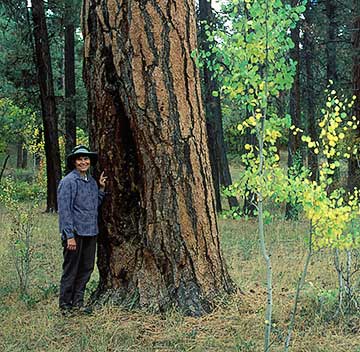NATURAL HISTORY COURSES THAT WERE OFFERED DURING 2010
Note: These courses are no longer being offered.
Walking through the Seasons in the Ponderosa Pine Forest
A course that explores the forest world near Allenspark
If you set out to learn about what goes on in the forest you will never be bored.
The stories go on forever . . . Joan Maloof
The ponderosa pine forest is home to a fascinating array of plants and wildlife, each one worthy of our study and
appreciation. And their relationships with each other are even more intriguing. In this course we will explore the life
histories of some of the plants, animals, birds, and insects that live all around us. Each season we will walk the same trail
near Allenspark, unearthing some of the stories the forest has to tell--stories that reveal the relationships that shape life in
the pine forest.
The lives of ponderosa pine trees, for instance, are interwoven with the lives of truffles, tree squirrels, forest hawks, and
many others. The pines, like many other plants, have developed mutually beneficial relationships with root fungi that
extend the reach of tree roots so they can absorb more water and minerals from the soil. The fungi can even protect the
trees from certain diseases. The pines, in turn, provide sugars that the fungi absorb from the tree roots.
The truffles, or fruiting bodies of the fungi, grow underground, but their scent is an advertisement to hungry squirrels and
other small mammals. Tassel-eared squirrels feast on the truffles, passing the fungal spores unharmed through their
digestive tracts, along with a bit of natural fertilizer, dispersing the fungi throughout the forest, which benefits both pine
trees and root-fungi. The truffles, in addition to providing nutrition for the squirrels, stimulate the growth of bark-
digesting microbes in the squirrels’ digestive system. The inner bark of pine twigs just happens to be one of the primary
winter foods for tassel-eared squirrels!
The squirrels, in turn, are eaten by northern goshawks, who also hunt chipmunks, chickarees, and birds like band-tailed
pigeons, hairy woodpeckers, and Steller’s jays, to name a few. But the goshawk is a story for another day.
Part I of the course begins in March with an indoor class and slide show where we will review the identification and
adaptations of forest plants, birds, mammals, and insects, and look at our own influence on ponderosa pine forests.
During our March walk we will observe our resident birds and learn their calls, identify forest trees and shrubs, and look
for tracks in the snow. In May we will track the return of migrant birds, the emergence of spring wildflowers, the flights
of spring butterflies, and the mating and nesting rituals of forest birds.
Part II of the course begins in July with an indoor class, continuing our work on identification and adaptations of forest
wildlife. During our July walk we will observe the fledging of young birds, the antics of small mammals, the flight of
summer butterflies, and the continuing procession of wildflowers. In September we will watch migrant birds heading
south, animals preparing for the coming of winter, and autumnal colors returning to trees and shrubs.
During each field trip we will spend some time sitting quietly, recording our observations and reflections (including
drawings, photographs, and poems, if you desire), creating a journal of what we have learned and experienced during our
walk through the seasons. Throughout the course we will try to weave together the strands that form the tapestry of forest
life, attempting to expand our perceptions of forest ecosystems and to better understand our own influence on the
ponderosa pine forests of the West.
My background: I am a naturalist, writer, and teacher, and enjoy sharing my boundless curiosity about ponderosa pine
forests. After moving to Boulder County in 1984, I taught classes and conducted botanical studies for many years in
forests managed by the city and county of Boulder. I am currently writing a book about the natural history of ponderosa
pine forests.
Part I—Winter and Spring
Indoor class: Thursday, March 18th, 6:30 to 8:30 pm
Field Class: Saturday, March 20th, 8:00 am to 1:00 pm
Field Class: Saturday, May 29th, 8:00 am to 1:00 pm
Part II—Summer and Fall
Indoor class: Thursday, July 15, 6:30 to 8:30 pm
Field Class: Saturday, July 17, 8:00 am to 1:00 pm
Field Class: Saturday, September 18, 8:00 am to 1:00 pm
Tuition for each Part: $90 ($80 for BCNA members).
Scholarships are available for all BCNA classes.
Limited to 12 participants.
These classes were offered through the Boulder County Nature Association.
These classes are currently not being offered.
See www.bcna.org for membership information and a listing of other course offerings.
Contact Dianne at dandrews@boulder.net
